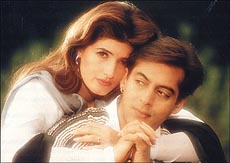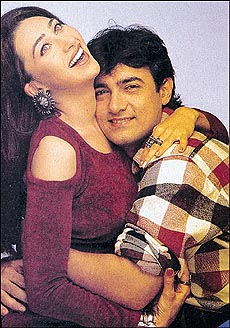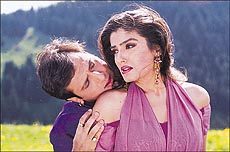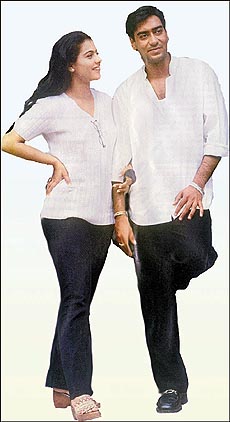




















 

 |
Cinema’s
Glorious Decade
By Abhilaksh
Likhi
POPULAR Indian cinema of the 90s
is at its pervasive best. As one of the mass media that
draws extensively from our cultural resources, its
dominant role in shaping the changing Indian
consciousness is stupendous. Crucial to the above context
is the multi-sensual communication so evidently built in
the contemporary film maker’s craft. The same
creates the apt cinematic environment to both entertain
and engage the audience. Varied nuances of character
motivation, plot delineation, camera angles, music, set
design, lighting, acoustics and editing enable a deep
involvement and identification with film makers’
thematic and emotional concerns within the secure
environs of the darkened hall.
 Consequently,
whether the film-maker highlights the changes within the
matrix of the family, or deals with the delicacies of
heroism, youth and romantic love, most successful screen
stories have usually displayed an intense engagement with
virtues and woes of values, attitudes and social
perceptions of our times. What is, however, remarkable is
that while narrative styles may have varied, the
cinematic experience in itself has achieved such a
masterly and complete life form in the 90s that it
attracts even larger crowds than ever. Consequently,
whether the film-maker highlights the changes within the
matrix of the family, or deals with the delicacies of
heroism, youth and romantic love, most successful screen
stories have usually displayed an intense engagement with
virtues and woes of values, attitudes and social
perceptions of our times. What is, however, remarkable is
that while narrative styles may have varied, the
cinematic experience in itself has achieved such a
masterly and complete life form in the 90s that it
attracts even larger crowds than ever.
In the above context,
one of the most enduring enigma of native movielore has
been the unprecedented success of Hum Apke Hain
Kaun. Sooraj Barjatya deftly weaves a pristine love
story in the backdrop of family ties, filial bonds and
fraternal camaraderie. He in fact brings to the forefront
what has always been uppermost in the average Indian
psyche: the family. Though dramatically etched with long
stretches of engrossing songs (14 songs) and interspersed
with short tracts of dialogue, the film nevertheless
depicts a well oiled, self propelling social set-up in
which discord is an alien entity. The moral code and
behavioral patterns that govern parents, uncles, sons,
daughters and lovers derive legitimacy from ancient
religious texts. And in Barjatya’s celluloid family,
modernity is permissible only in material terms — an
expanding business empire or perhaps a sprawling bungalow
— the interiors of which reflect, glamour and
grandeur both.
 Interestingly, within this milieu all
screen characters in HAHK do not clamour for
distinct identities. Nisha (Madhuri Dixit) and her sister
(Renuka Sahane), for instance, may be excelling in
computers and painting with consummate skill but they
prefer to sacrifice their love rather than to protest
against adult interference. The traditional balance is
thus carefully reinstated in the family hierarchical
structure. Further, HAHK reaches the climax only
through divine intervention, entering the pet dog’s
psyche to bring about a union of the to be separated
lovers. Barjatya’s cinema thus aims at the ideal
state where everything and everyone is well adjusted and
pre- ordained. However, the story line is suitably
compensated by a narrative that sketches filial harmony
to the core and a music track that perfectly matches the
central sentiments of the film. Interestingly, within this milieu all
screen characters in HAHK do not clamour for
distinct identities. Nisha (Madhuri Dixit) and her sister
(Renuka Sahane), for instance, may be excelling in
computers and painting with consummate skill but they
prefer to sacrifice their love rather than to protest
against adult interference. The traditional balance is
thus carefully reinstated in the family hierarchical
structure. Further, HAHK reaches the climax only
through divine intervention, entering the pet dog’s
psyche to bring about a union of the to be separated
lovers. Barjatya’s cinema thus aims at the ideal
state where everything and everyone is well adjusted and
pre- ordained. However, the story line is suitably
compensated by a narrative that sketches filial harmony
to the core and a music track that perfectly matches the
central sentiments of the film.
On the other hand, the
success of Aditya Chopra’s debut film Dil Wale
Dulhaniya Le Jayenge can be largely attributed to the
fact that it unabashedly romanticised the
"loser" image, bringing to fore a clear cut
conformist hero. Unlike the angry young lovers of the
1980s perfected in films like Qayamat Se Qayamat Tak
or Sadak, Raj (Shahrukh Khan) is neither angry nor
rebellious. He is desperately in love with Simran but
instead of turning his back to familial discord, he longs
for acceptance. His entry into the girl’s household,
his participation in her marriage preparations (with the
popular track Doli Sajake Rakhna mesmerising the
masses) and the hope to win over the family members,
depicts an intense reverence to behavioural codes
sanctified by tradition and custom. Interestingly, this
is what makes him a ‘hero’. The allure of this
90s man can be traced to certain time-tested values:
respect for elders, obedience to the patriarchal law and
an overwhelming desire to belong to the fold, clan,
community or tribe. Thematically, DDLJ is a simple
love story retold with a shifting focus, old-fashioned
mores blending effortlessly with refreshing modernism in
the backdrop of the emotional travails of NRI families.
However, with beautifully cinematographed sequences and
intense portrayals DDLJ’s narrative showcases
the yearings of new generation without the usual hype of
mainstream kitsch.
 While conformism and preordained behaviour
mark the cinematic structure of HAHK and DDLJ,
Raja Hindustani (directed by Dharmesh Darshan)
infuses the luminiscent quality of innocence with
progressive values that could tear apart class
differences. The tender bonding between Raja (Aamir
Khan), the cab driver, and the rich heiress (Karisma
Kapoor) in the backdrop of bedazzling landscapes unfolds
the overcoming of fear, reserve and distancing, so
obvious in a class-driven society. The film’s text
is a revelation more about attitudes than about
relationships. While conformism and preordained behaviour
mark the cinematic structure of HAHK and DDLJ,
Raja Hindustani (directed by Dharmesh Darshan)
infuses the luminiscent quality of innocence with
progressive values that could tear apart class
differences. The tender bonding between Raja (Aamir
Khan), the cab driver, and the rich heiress (Karisma
Kapoor) in the backdrop of bedazzling landscapes unfolds
the overcoming of fear, reserve and distancing, so
obvious in a class-driven society. The film’s text
is a revelation more about attitudes than about
relationships.
Raja may be a simpleton
who wears his heart on his sleeve but his determination
to recreate a lost world of innocence amidst scheming
in-laws and a misled wife enables him to return with his
child to his sanctified home. In Dharmesh’s
cinematic credo the stereotype thus becomes novel and the
common place acquires the chimera of originality.
Besides, an empathetic treatment in an otherwise foregone
and predictable narrative uplifts the dramatic core of a
film in which a scintillating musical score too is indeed
a highlight.
Stylistically speaking,
all the three films indulge in cinematic imagery that
mirrors a social order without too many moral dilemmas.
They could also be termed as romantic musicals that are
secular in outlook but nonetheless use religious concepts
to structure the narrative and impart the latter with
deeper layers of meaning. Their demeanour, decor and
gesture motivation not only convey the nature of the
characters but also explore changing modes of mythic
consciousness. This has indeed nurtured the basis of a
carefully articulated morality play that has increasingly
become an integral part of the collective cinematic
psyche of the country.
 This is
also fairly evident from the success of two recent films
— Dil To Pagal Hai and Kuch Kuch Hota Hai.
Both are about love, friendship and commitment. Both seem
to take a sympathetic look at situations where conflicts
are internalised. Both give the impression that they wish
to delve deep into the human predicament of
circumstances. Both are paradoxically about upper class
ambience, and underscore the agony, ecstasy and
expression of the romantic aura. And both are love
stories which by bizarre coincidence end up us fairy tale
love triangles. This is
also fairly evident from the success of two recent films
— Dil To Pagal Hai and Kuch Kuch Hota Hai.
Both are about love, friendship and commitment. Both seem
to take a sympathetic look at situations where conflicts
are internalised. Both give the impression that they wish
to delve deep into the human predicament of
circumstances. Both are paradoxically about upper class
ambience, and underscore the agony, ecstasy and
expression of the romantic aura. And both are love
stories which by bizarre coincidence end up us fairy tale
love triangles.
But with easy straddling
of characters across the two worlds of modernity and
tradition, both DTPH and KKHH enable the
vast mass of people to come to term with social
modernisation even while retaining their Indianness.
Rahul (played by Shah-Rukh Khan in both films), Pooja
(Madhuri Dixit in DTPH) and Tina (Rani Mukerjee in
KKHH) are youthful, energetic and modern but what
lends their characterisation intensity and depth is a
typically Indian consciousness rooted in good values.
Rahul’s intensive ravings about ‘Maya’ in DTPH)
do, indeed, take us deeper into the real world of his
inner self. Of course, both Yash Chopra and Karan Johar
also skillfully capture the designer glitz and glamour,
in the backdrop of melodious music and breathtaking
scenery, with conviction and cinematic finesse.
While cinematic
representation of a changing Indian consciousness may
have been carefully articulated by successful film makers
of the 90s, critics have often viewed this as a depiction
of a conflict between westernisation and tradition. In
the backdrop of dazzling stagecraft, well-etched
characters, humour, melodious songs and melodrama, the
real contest, however, is between religious values and
secular values. With emotions always in excess of what
the situation demands, acting styles and a personalised
treatment have further made a tremendous difference to
the popularity of these films. But this is not to deny
that in today’s popular cinema, reality, dream,
magic, intellect and emotion metamorphosise into a
cinematic language that engages itself not only with the
audience but with contemporary times, too.
|

